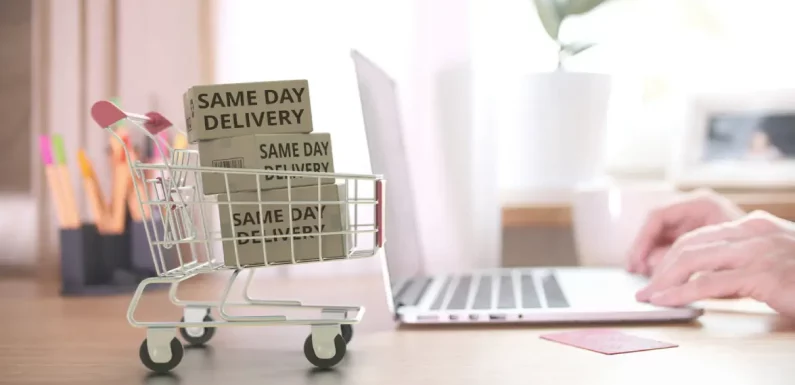
Introduction
When Lisa unexpectedly needed a gift delivered to her friend’s birthday party across town in just a few hours, she panicked about how to get it there on time. But thanks to same-day delivery, the present arrived at the party mere hours after Lisa purchased it online. She breathed a sigh of relief, knowing the delivery service had her back.
Stories like Lisa’s highlight the growing demand for immediacy. Consumers expect to get products and services as fast as possible, even same-day. The rise of on-demand delivery startups catering to these expectations has completely changed customer mindsets around fulfillment speed.
Same-day shipping was once considered an extravagant premium but accelerated expectations and maturing logistics push it towards the norm. Retailers are scrambling to keep pace as consumers’ need for speed reshapes commerce and logistics.
Consumers’ Expectations for Immediacy
On-demand services like Uber and Amazon Prime have conditioned today’s consumers to expect gratification in hours or minutes with little planning. Ordering products, food or services for near-instant consumption feeds an appetite for instantaneity.
When given a choice between same-day, next-day or standard shipping times, 59% of consumers will choose the fastest option even at a greater cost. And almost three-quarters expect same-day or faster delivery to be free.
This thirst for swift gratification is recalibrating perceptions around fulfillment speed. Quick delivery was once considered costly, but it is increasingly becoming the baseline expectation, especially in crowded urban centers.
Younger demographics like millennials and Gen Z have less tolerance for delayed gratification. Having grown up with on-demand digital services, waiting days or weeks for physical products feels arcane to these consumers.
Logistics of Same-Day Delivery
Offering same-day delivery poses steep logistical challenges. The process must be streamlined to squeeze fulfillment and last-mile delivery into hours.
Warehouses have to be located close to population centers to minimize transit time. Inventory and order information needs real-time synchronization across sites to enable swift processing and bundling after purchase.
Sophisticated route optimization algorithms ensure couriers receive orders with enough time and efficiency to complete multiple short-distance deliveries per day. Machine learning improves the prediction of delivery demand patterns.
Some retailers maintain their dedicated fleets of drivers and vehicles. Others partner with third-party same-day shipping services that leverage crowdsourced couriers. These contracted shoppers retrieve and deliver orders using their cars and bikes.
Key Players in the Same-Day Delivery Market
Major retailers like Amazon, Walmart, and Target have all invested heavily in supply chain capabilities to accelerate deliveries, notably through expansive brick-and-mortar networks that double as local fulfillment centers.
Amazon’s Prime Now service offers 1-2 hour delivery on various products in certain areas. Walmart and Target have steadily grown the number of items eligible for same-day pickup and local delivery.
Pure-play delivery startups like Instacart and DoorDash focus solely on the speedy fulfillment of everything from groceries to restaurant meals. Other same-day delivery courier services like Gold Rush ensure your medical and legal packages will be delivered at the time of need.
Niche startups also cater to specific categories like perishable grocery delivery in under an hour (Gopuff) or pharmaceutical same-day delivery (ScriptDrop). The variety of players signals how pervasive the demand for instantaneity has become.
Benefits of Same-Day Shipping
Rapid same-day delivery provides retailers and restaurants with a key competitive advantage by satisfying customer expectations. Quick fulfillment conveys reliability and service quality.
Same-day delivery unlocks convenience for items like groceries and household products needed on short notice. It allows retailers to capture impulse purchases and capitalize on immediate gratification urges.
Pizza chains, florists, and gift shops have long offered expedited deliveries for last-minute needs. Now, that capability is expanding to almost every retail category imaginable.
Same-day shipping also supports customer retention. According to a Walker Sands survey, 60% of consumers say same-day delivery would make them more loyal to retailers. Fast fulfillment is becoming a brand differentiator.
Challenges Facing the Industry
Despite its growth, same-day delivery faces obstacles around costs and operational complexity. The logistical gymnastics required to enable quick turnarounds leave thin profit margins.
Legacy retailers must adapt supply chains designed for slower fulfillment to enable same-day capabilities. Small businesses often need more resources and technology for rapid delivery at scale.
Crowdsourced courier networks keep labor costs flexible but have faced scrutiny over contractor treatment and retention. And city congestion strains speed as demand spreads across metro areas.
Some consumers need to improve at paying the premiums often charged for same-day delivery compared to standard shipping. And weekends see lower demand, making it harder for providers to justify added weekend staffing costs.
The Future of Same-Day Delivery
E-commerce analysts still foresee strong growth for same-day delivery, projecting the global market to reach over $20 billion by 2025. Investments in logistics infrastructure will help same-day become more efficient and accessible.
Advances in delivery robots and drones could significantly reduce reliance on costly human couriers. Some providers already use autonomous ground vehicles to handle short-distance same-day deliveries.
Machine learning and predictive analytics will enable dynamic re-routing of deliveries as conditions change. Shifting towards alternative energy fleets will mitigate growing environmental concerns.
While still in its infancy, same-day delivery has already begun recalibrating consumer expectations. The promise of getting nearly anything delivered within hours will likely upend retail for good.
Conclusion
Fueled by the instant gratification economy, same-day delivery is transitioning from luxury to expectation. Consumers gravitate towards retailers meeting their need for speed with quick fulfillment.
Logistics providers enable this by optimizing every facet of the delivery process. And startups catering specifically to accelerated delivery are thriving in the on-demand economy.
Same-day shipping comes with obstacles, but the acceleration of e-commerce and desire for immediacy ensure its role will only grow. As patience wears thin, the future of retail will go to those delivering at the speed of now.
